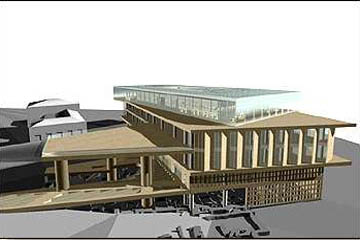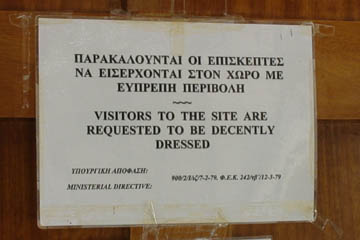Modern Art and Classical Architecture
This Saturday sees the opening of Athen's new museum of the Parthenon, intended to replace the rather small and cramped museum crowded in at one end of the Acropolis. Designed by Bernard Tschumi Architects, you might have thought that the architects would break the habit of a lifetime and actually design something that uses some of the language of classical architecture - fluted columns, acanthus leaf capitals, golden mean proportions and all the rest of it. Certainly if you read the architect's blurb, you might be excused for thinking so.

|
| The architect's impression of the museum. The reality is no better. |
The devastating clue comes in the claim that the new building "blends" with the site - the other death knell is the word "harmonise". Whenever you see those words you can guarantee that the design will be a more than usually offensive concrete box. Such is the case with the new Parthenon Museum. Set in a position where you simply cannot ignore it or pretend that it isn't there, the building is a mishmash of soaring concrete curves, glass walls, plain concrete slabs and glass floors. As an avant garde construction in Brasilia it would be fine; set in some brash modern office district it would harmonise beautifully; plonked in the middle of Athens, surrounded by the remains of classical architecture it is worse than a clash of styles - it is cultural vandalism.
No doubt the display areas will be bright and modern and will show off the sculptures and art works of the Acropolis splendidly with subdued lighting, computer graphics to enhance the "visitor experience", and a large area crammed with tawdry souvenirs and over-priced books, intended to extract the last drachma from the tourist - but you could do just the same with a modern museum in Munich or Acapulco. The only comfort for the lover of art is that the Elgin Marbles have been spared the degradation of being stuck in this glass-and-concrete packing case.
The British Museum, a splendid building whose soaring columns and grand staircases reflect the best of Europe's classical heritage, is a most fitting repository for the broken statues saved by Lord Elgin from their Greek owners who were busy turning thm into lime - fertiliser, fields, for the spreading of - by the simple expedient of smashing them into small chunks and baking them in a kiln. Not only did he save them from the 18th century Greeks but, unintentionally he saved them from their modern descendants. One of the less publicised aspects of the new museum is that it is hermetically sealed against the corrosive pollution of Athens' air which has reduced the few statues that remained on the Acropolis to near shapeless lumps of eroded marble. The much-photographed caryatids that support the porch of the Erechtheum on the Acropolis are, in fact, replicas of the one that Lord Elgin saved.
Naturally the Greeks want the Elgin Marbles back again, seemingly unaware of the fact that while finders may not be keepers, purchasers are. The motive behind this desire was summed up by one our guides who, almost in tears over the issue, wailed, "But no one is making any money out of them!"

|
| The sign at the entrance to the Mycenae Museum: visitors in shorts are not welcome! |
Today the Elgin Marbles stand in a grand hall, no admission charge, no restrictions on photography, no compulsory guides, and footweary visitors can sit on comfortable padded benches and view or sketch them at leisure. If the Marbles were to return to Greece they would be locked away where only tourists with copious pockets could see them, offensive guards would harrass visitors at every turn - just look at what happens in the National Archaeological Museum in Athens - and if your girl-friend happened to stand in front of a marble slab while you photographed it the aforesaid guards would descend upon you, whistles blowing, faces purple with rage, and you would be all but frogmarched out of the museum.
Of course the Greeks will go on about their intense feeling for their history and culture and how the cold British are not suitable keepers of the finest art produced in Greece. The depth of their feeling and sensitivity is shown by their desecration of the Plain of Marathon which was dug up to provide a swimming pool for the Athens Olympics - and large swathes of Athens itself were similarly vandalised in the same cause. Then they have the cheek to claim that the "No posing" rule is because their national feelings are outraged by shirtless tourists photographing each other in front of statues of nude athletes.
I have no objection to the British Museum providing replica copies of the Elgin Marbles to the Greeks - provided they ask nicely and pay the appropriate fees. Should the Marbles be returned to Greece? Definitely not! People who can think that the new museum is a fitting complement to the classical splendour of the Acropolis are not fit guardians for Europe's heritage.
your girl-friend You think I'm exaggerating? Up on the Acropolis there are signs in various languages explicitly forbidding visitors to pose in front of the antiquities. The same rule applies in Olympia, where tourists who want to pose dramatically on the starting blocks in the stadium while being photographed are interrupted by whistle-blowing guards yelling "No photo! No photo!" As for the rudeness of the staff at the National Archaeological Museum ... the less said the better. Return
© Kendall K. Down 2009





